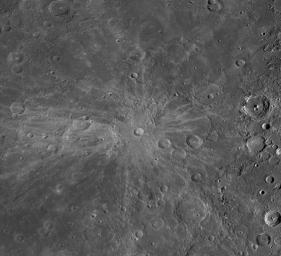
|
Meteorites
- Click the image above for a larger view
- Full-Res JPEG (652 x 595) (61.1 kB)
- Full-Res TIFF (652 x 595) (388.6 kB)
Caption:
Most meteorites are pieces of asteroids. About 130 meteorites have been linked to an origin on the planet Mars, and nearly 200 meteorites originated on the Moon. No meteorite has been convincingly shown to have come from Mercury. Impact cratering events on Mercury may blast material off the surface, but it is much more difficult for such material to move into an orbit that could intersect the orbit of Earth, compared with material derived from the Moon or Mars. In 1992, Stan Love and Klaus Keil published a study describing the likely characteristics of a mercurian meteorite. A recent re-look at the topic of meteorites from Mercury, by Will Vaughan and Jim Head , pointed out that the dynamics of ejection are such that the most likely locations for source craters on Mercury are in regions centered on 90° and 270° E longitude.
Fonteyn crater, shown in today's gallery image, is a fresh 29-km diameter impact structure centered at about 33° N and 95° E, within the probable zone noted by Vaughan and Head. Fonteyn has a somewhat asymmetrical pattern of bright rays, suggesting that it formed in an oblique impact , which may favor ejection of material at speeds greater than escape velocity. Could the Fonteyn impact have launched material that has fallen on Earth, or is on its way?
This mosaic is a portion of MDIS's high-resolution surface morphology base map. The surface morphology base map covers more than 99% of Mercury's surface with an average resolution of 200 meters/pixel. Images acquired for the surface morphology base map typically are obtained at off-vertical Sun angles (i.e., high incidence angles) and have visible shadows so as to reveal clearly the topographic form of geologic features.
Image:
This is a portion of the MDIS monochrome base map mosaic.
Instrument:
Wide Angle Camera (WAC) of the Mercury Dual Imaging System (MDIS)
WAC filter:
7 (748 nanometers)
Scale:
The scene is about 730 km (450 mi.) wide.
Background Info:
The MESSENGER spacecraft is the first ever to orbit the planet Mercury, and the spacecraft's seven scientific instruments and radio science investigation are unraveling the history and evolution of the Solar System's innermost planet. MESSENGER acquired over 150,000 images and extensive other data sets. MESSENGER is capable of continuing orbital operations until early 2015.
For information regarding the use of images, see the MESSENGER image use policy .
Cataloging Keywords:
| Name | Value | Additional Values |
|---|---|---|
| Target | Mercury | Mars |
| System | ||
| Target Type | Planet | |
| Mission | MESSENGER | |
| Instrument Host | MESSENGER | |
| Host Type | Orbiter | |
| Instrument | Mercury Dual Imaging System (MDIS) | |
| Detector | Wide Angle Camera (WAC) | |
| Extra Keywords | Asteroid, Crater, Grayscale, Impact, Map, Moon, Radio, Shadow | |
| Acquisition Date | ||
| Release Date | 2014-04-11 | |
| Date in Caption | ||
| Image Credit | NASA/Johns Hopkins University Applied Physics Laboratory/Carnegie Institution of Washington | |
| Source | photojournal.jpl.nasa.gov/catalog/PIA18212 | |
| Identifier | PIA18212 | |
